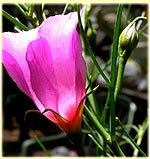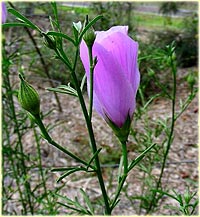 |
| Search this site: |
Alyogynes in the Sub-tropics. Selected species and Crosses
Written for the Association of Societies for Growing Australian Plants, Hibiscus and Related Genera Study Group.PART 2 ALYOGYNE HAKEIFOLIA.
INTRODUCTION
In Part 1, writing of Alyogyne huegelii, it was noted that initial attempts at growing them, in two different gardens, were spectacularly unsuccessful. If we were referring to Alyogyne hakeifolia, we would have to say that attempts at growing them in three different gardens have been an abject failure. The plants grow well initially but as soon as the humidity of a normal summer manifests itself, the A. hakeifolia plants die, literally overnight. I would be ashamed to list the number of A. hakefolia labels that are beside me as I write.
This sudden death attribute is not surprising, given that Alyogyne hakeifolia has a similar, but more inland, distribution to Alyogyne huegelii.
The initial Alyogyne hakeifolia plants were again purchased at an interstate nursery. The labels just had print without any illustration and indicated that Alyogyne hakeifolia was an evergreen tall shrub with narrow leaves and large yellow or mauve flowers in spring and summer. The label also indicated that the plant tolerates lime, drought and salt soils and is usually frost resistant. Depending on the colour purchased, the other colour was crossed out. It should be noted that although the label indicated the plant had mauve flowers, in fact, we would describe the blooms as pink.
NOTE: Before I obtained the mauve form, I found that a friend in Victoria, initially from overseas, had what she described as the mauve form of Alyogyne hakeifolia. She sent cutting material and I propagated these, only to find that what she called ‘mauve’, I called ‘pink’. I found similar confusion with another friend from overseas so am noting this to indicate that what we perceive as pink may not be perceived that way outside Australia.
The plants purchased interstate were also nursed on a plane and initially made rapid progress, flowered profusely and set seed. However, all, including seedlings grown from seed, succumbed rapidly to summer moisture. After some time, Alyogyne hakeifolia plants with beautiful illustrated labels became available. The label included a photo of the bush and a bunch of flowers. The pink form was called A. “Melissa Anne”, the yellow form A. “Elle Maree” and there was a form called A. “Shelby Ann” which had mauve flowers. The A. “Shelby Ann” label describes the flowers as purple.
As I particularly love white or cream flowers, I planted seed of Alyogyne hakeifolia obtained from a seed company in Western Australia. Initially I had no success but I planted more seed many years later and ended up with viable seedlings. The other forms that we had grown were around 2 metres whereas this form could only be described as a small tree. It probably lives longer here than the other colours. I love it so much that I have risked planting it yet again. See FIGURE 1.
 |
 |
 |
 |
| FIGURE 1: Different colours of Alyogyne hakeifolia | |||
I was a bit upset about the short life of Alyogyne hakeifolia plants in a normal summer here when a friend in California told me of the spontaneous crosses she had observed in a garden where both Alyogyne huegelii and Alyogyne hakeifolia were growing near her. Another friend has since sent photos of these. Alyogyne huegelii flowers earlier here than A. hakeifolia, however the pink tulip-shaped form of A. huegelii flowers mid-way between A. huegelii and A. hakeifolia and so was an ideal candidate for crosses, as it was still in flower when A. hakeifolia started to bloom. I had a pink flowering A. huegelii and a pink flowering A. hakeifolia in pots and that made crosses very simple.
The results however were somewhat of a surprise. All seedlings had purple flowers. The foliage was similar in all seedlings. Only the form with the finest foliage was retained. This foliage provides a contrast to the foliage of Alyogyne “Blue Moon” (see next paragraph), unlike the foliage shown under the seeds in the first image of FIGURE 2i which is very similar to the foliage of Alyogyne “Blue Moon” in FIGURE 3. Different types of foliage from the A. huegelii x A. hakeifolia cross can be observed in FIGURE 2ii. The retained cross lives as long here as Alyogyne huegelii, so the crosses were successful in that a form with much longer life was obtained. As well, the foliage is attractive even when the plant is not flowering. The seedling was named A. ‘Montburg Purple’ after the nursery of a friend who has Alyogynes available online in Victoria. I found it very interesting to observe the difference in seeds. It was quite easy to tell whether a cross had been achieved by observing the seed. See FIGURE 2.
A plant with interesting foliage was purchased in Victoria as Alyogyne huegelii, fine leaf form. This plant was given to a propagator at a nursery in Brisbane. These plants have been called A. “Blue Moon”. The flower is lighter in colour than Alyogyne “Montburg Purple” and the two look attractive growing together but unfortunately, I have been unable to keep A. “Blue Moon” alive here. The plants grow into stunning specimens and then die, virtually overnight. See FIGURE 3.
FAQs | Links | Contact Us | Privacy Policy
Copyright © 2000-2011 hibiscus.org All rights reserved.
Featuring a selection of classic hymns performed on piano and organ, with lyrics, free for reuse









